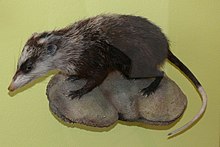Moonrat
| Moonrat[1] | |
|---|---|

| |

| |
| Museum specimens of the two moonrat subspecies: E. g. gymnura (above) | |
| Scientific classification | |
| Domain: | Eukaryota |
| Kingdom: | Animalia |
| Phylum: | Chordata |
| Class: | Mammalia |
| Order: | Eulipotyphla |
| Family: | Erinaceidae |
| Subfamily: | Galericinae |
| Genus: | Echinosorex Blainville, 1838 |
| Species: | E. gymnura
|
| Binomial name | |
| Echinosorex gymnura (Raffles, 1822)
| |

| |
| Moonrat range | |
The moonrat (Echinosorex gymnura) is a southeast Asian species of mammal in the family Erinaceidae (hedgehogs and gymnures). It is the only species in the genus Echinosorex. The moonrat is a fairly small, primarily carnivorous animal which, despite its name, is not closely related to rats or other rodents. The scientific name is sometimes given as Echinosorex gymnurus, but this is incorrect.[1]
Description
The moonrat has a distinct pungent odor with strong ammonia content, different from the musky smell of carnivores.[3] There are two subspecies: E. g. gymnura is found in Sumatra and the Thai-Malay Peninsula; E. g. alba is found in Borneo.[4] In the former the head and frontal half of the body are white or grey-white; the remaining is mainly black.[5] The latter subspecies is generally white (alba means white in Latin), with a sparse scattering of black hairs; it appears totally white from a distance. Those from western Borneo tend to have a greater proportion of black hairs than those from the east, but animals from Brunei appear intermediate.[4] Largely white E. g. gymnura also occur, but they are rare.[5]
Head and body length is 32–40 cm (13–16 in), tail length is 20–29 cm (7.9–11.4 in),[6] hind foot length is 6.5–7.5 cm (2.6–3.0 in) and weight is 870–1,100 g (1.92–2.43 lb).[5] The dental formula is 3.1.4.33.1.4.3 × 2 = 44.[4] It is possibly the largest member of the order Erinaceomorpha, although the European hedgehog likely weighs a bit more at 1,000 g (2.2 lb) and up to 2,000 g (4.4 lb).[7]
Distribution
Moonrats inhabit most jungle terrain in southern Myanmar, Peninsular Thailand, Peninsular Malaysia, Borneo and Sumatra. Although they are closely related to the short-tailed gymnure (Hylomys suillus) and to the hedgehog, full grown specimens more closely resemble large rats, with which they share similar habits and ecological niches.[8] In Borneo, they occur at many sites throughout the lowlands and up to 900 m in the Kelabit Highlands. They appear to be absent or rare in some localities, possibly due to a shortage of suitable food.
Ecology and habitat
Moonrats are nocturnal and terrestrial, lying up under logs, roots or in abandoned burrows during the day. They inhabit moist forests including mangrove and swamp forests and often enter water.[2][5] In Borneo, they occur mainly in forests, but in peninsular Malaysia they are also found in gardens and plantations. They feed on earthworms and various small animals, mostly arthropods. The Moonrat is a host of the Acanthocephalan intestinal parasite Moniliformis echinosorexi.[9]
Behavior and reproduction
Moonrats release strong odours with a strong ammonia content to mark the edges of their territories and warn other moonrats to stay away with threatening hisses also to ward off predators. Adults live alone. When they are preparing to have young, they will make nests mostly from leaves. Females usually have two babies at one time.
Diet
The moonrat is an omnivore, known to eat a wide range of invertebrates—for example, worms, insects, crabs and other invertebrates found in moist areas. They will also eat fruit, and occasionally frogs or fish.
Lifespan
The lifespan of the moonrat is up to five years.[10]
Conservation status
The moonrat is not considered a threatened species. The main threat to the moonrat is deforestation activities due to human development for agriculture, plantation, and commercial logging. Moreover, other demands from Penan in Borneo for food and traditional medicinal contribute to decreasing numbers of moonrats in Borneo.[8] The species is also found in protected areas, including Matang National Park and Kuching Wetlands National Park. Its IUCN status is Least Concern.[2]
Economic importance
The Penan in Borneo used to trade moonrat meat for other foods and goods among themselves and for money.[10][dead link]
References
- ^ a b Hutterer, R. (2005). "Order Erinaceomorpha". In Wilson, D.E.; Reeder, D.M (eds.). Mammal Species of the World: A Taxonomic and Geographic Reference (3rd ed.). Johns Hopkins University Press. p. 218. ISBN 978-0-8018-8221-0. OCLC 62265494.
- ^ a b c Lunde, D.; Meijaard, E.; Ruedas, L.; van Strien, N.J. (2008). "Echinosorex gymnura". IUCN Red List of Threatened Species. 2008. Retrieved 6 April 2011.
{{cite journal}}: Invalid|ref=harv(help); Unknown parameter|last-author-amp=ignored (|name-list-style=suggested) (help) - ^ Moonrat at the Encyclopædia Britannica
- ^ a b c Payne, J. and Francis, C. M. 2005. A Field Guide to the Mammals of Borneo. Sabah society, Malaysia ISBN 9679994716.
- ^ a b c d Francis, C.M. (2008). A field guide to the mammals of South-East Asia. New Holland Publishers (UK) Ltd. p. 176. ISBN 978-1-84537-735-9. Retrieved 2011-04-06.
- ^ Shepherd, Chris R.; Shepherd, Loretta Ann (2012). A Naturalist's Guide to the Mammals of Southeast Asia. Wiltshire, UK: John Beaufoy Publishing. p. 14. ISBN 978-1-906780-71-5.
- ^ Wood, Gerald (1983). The Guinness Book of Animal Facts and Feats. ISBN 978-0-85112-235-9.
- ^ a b Family Erinaceidae or gymnures and hedgehogs. Thewebsiteofeverything.com. Retrieved on 2012-12-19.
- ^ Deveaux, Timothy P.; Schmidt, Gerald D.; Krishnasamy, M. (1988). "Two New Species of Moniliformis (Acanthocephala: Moniliformidae) from Malaysia". The Journal of Parasitology. 74 (2): 322–5. doi:10.2307/3282462. JSTOR 3282462. PMID 3128654.
- ^ a b The Leading America Zoo Site on the Net. americazoo.com. Retrieved on 2012-12-19. Archived January 2, 2009, at the Wayback Machine
External links
- Echinosorex gymnura - Animal Diversity Web

